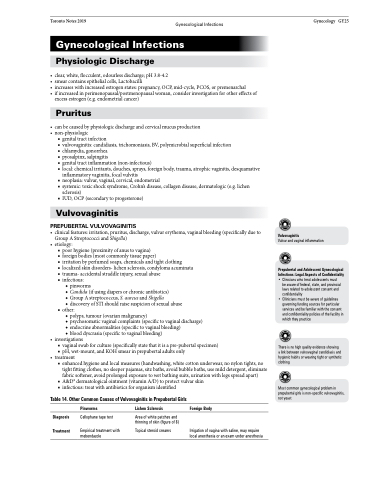Page 511 - TNFlipTest
P. 511
Toronto Notes 2019 Gynecological Infections Gynecological Infections
Physiologic Discharge
• clear,white,flocculent,odourlessdischarge;pH3.8-4.2
• smearcontainsepithelialcells,Lactobacilli
• increaseswithincreasedestrogenstates:pregnancy,OCP,mid-cycle,PCOS,orpremenarchal
• ifincreasedinperimenopausal/postmenopausalwoman,considerinvestigationforothereffectsof
excess estrogen (e.g. endometrial cancer)
Pruritus
• canbecausedbyphysiologicdischargeandcervicalmucusproduction
• non-physiologic
■ genital tract infection
■ vulvovaginitis: candidiasis, trichomoniasis, BV, polymicrobial superficial infection
■ chlamydia, gonorrhea
■ pyosalpinx, salpingitis
■ genital tract inflammation (non-infectious)
■ local: chemical irritants, douches, sprays, foreign body, trauma, atrophic vaginitis, desquamative
inflammatory vaginitis, focal vulvitis
■ neoplasia: vulvar, vaginal, cervical, endometrial
■ systemic: toxic shock syndrome, Crohn’s disease, collagen disease, dermatologic (e.g. lichen
sclerosis)
■ IUD, OCP (secondary to progesterone)
Vulvovaginitis
PREPUBERTAL VULVOVAGINITIS
• clinicalfeatures:irritation,pruritus,discharge,vulvarerythema,vaginalbleeding(specificallydueto Group A Streptococci and Shigella)
• etiology:
■ poor hygiene (proximity of anus to vagina)
■ foreign bodies (most commonly tissue paper)
■ irritation by perfumed soaps, chemicals and tight clothing
■ localized skin disorders- lichen sclerosis, condyloma acuminata ■ trauma- accidental straddle injury, sexual abuse
■ infectious:
◆ pinworms
◆ Candida (if using diapers or chronic antibiotics)
◆ Group A streptococcus, S. aureus and Shigella
◆ discovery of STI should raise suspicion of sexual abuse
■ other:
◆ polyps, tumour (ovarian malignancy)
◆ psychosomatic vaginal complaints (specific to vaginal discharge) ◆ endocrine abnormalities (specific to vaginal bleeding)
◆ blood dyscrasia (specific to vaginal bleeding)
• investigations
■ vaginal swab for culture (specifically state that it is a pre-pubertal specimen) ■ pH, wet-mount, and KOH smear in prepubertal adults only
• treatment
■ enhanced hygiene and local measures (handwashing, white cotton underwear, no nylon tights, no
tight fitting clothes, no sleeper pajamas, sitz baths, avoid bubble baths, use mild detergent, eliminate
fabric softener, avoid prolonged exposure to wet bathing suits, urination with legs spread apart)
■ A&D® dermatological ointment (vitamin A/D) to protect vulvar skin
■ infectious: treat with antibiotics for organism identified
Gynecology GY25
Table 14. Other Common Causes of Vulvovaginitis in Prepubertal Girls
Vulvar and vaginal inflammation
Prepubertal and Adolescent Gynecological Infections: Legal Aspects of Confidentiality
• Clinicians who treat adolescents must
be aware of federal, state, and provincial laws related to adolescent consent and confidentiality
• Cllinicians must be aware of guidelines governing funding sources for particular services and be familiar with the consent and confidentiality policies of the facility in which they practice
There is no high quality evidence showing
a link between vulvovaginal candidiasis and hygienic habits or wearing tight or synthetic clothing
Most common gynecological problem in prepubertal girls is non-specific vulvovaginitis, not yeast
Vulvovaginitis
Pinworms
Diagnosis Cellophane tape test Treatment Empirical treatment with
Lichen Sclerosis
Area of white patches and thinning of skin (figure of 8)
Topical steroid creams
Foreign Body
Irrigation of vagina with saline, may require local anesthesia or an exam under anesthesia
mebendazole


